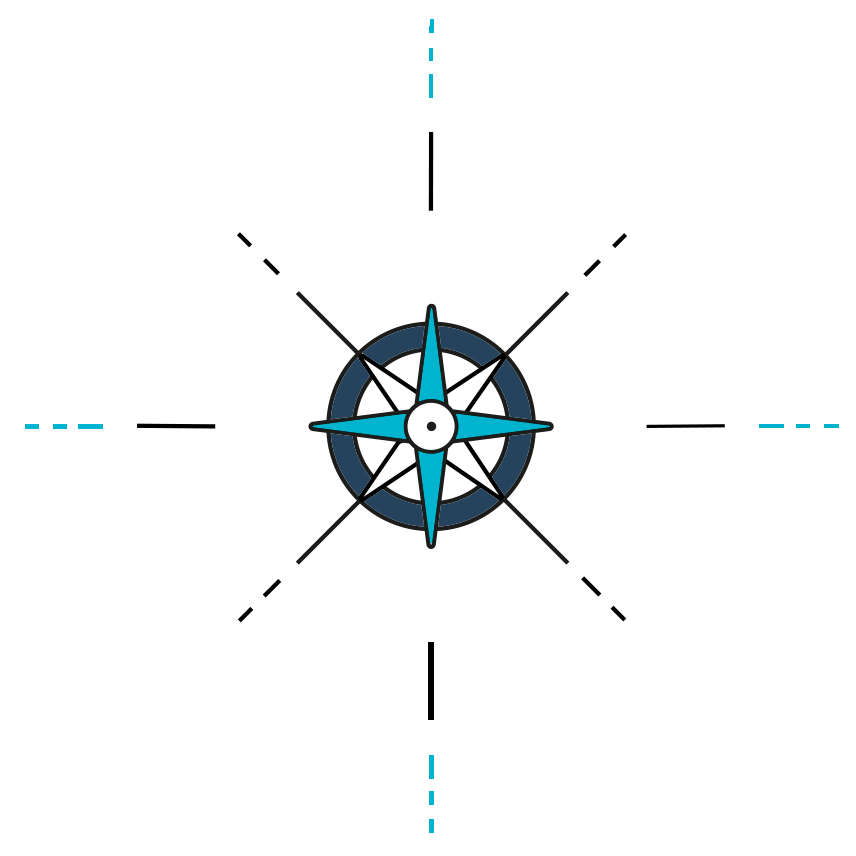Fez, cultural and religious epicentre of Morocco, is the oldest city in the country. It is also the city with the largest medina in the world (as well as the largest pedestrian area). If these facts haven’t already convinced you to visit this city, then keep reading to discover what to see and do in Fez, the (in our opinion) most impressive city in Morocco.
Why Fez?
Fez is not a beautiful city in the way we know. It’s chaotic, disorganised, and not necessarily clean or well preserved. However, or maybe for those reasons, it is real, authentic. Entering the medina feels like suddenly moving into another world, somehow traveling back in time, into a new world of colours, scents, sounds and flavours that you will hardly find anywhere else. That’s why, when traveling to Morocco, Fez should be a mandatory stop.
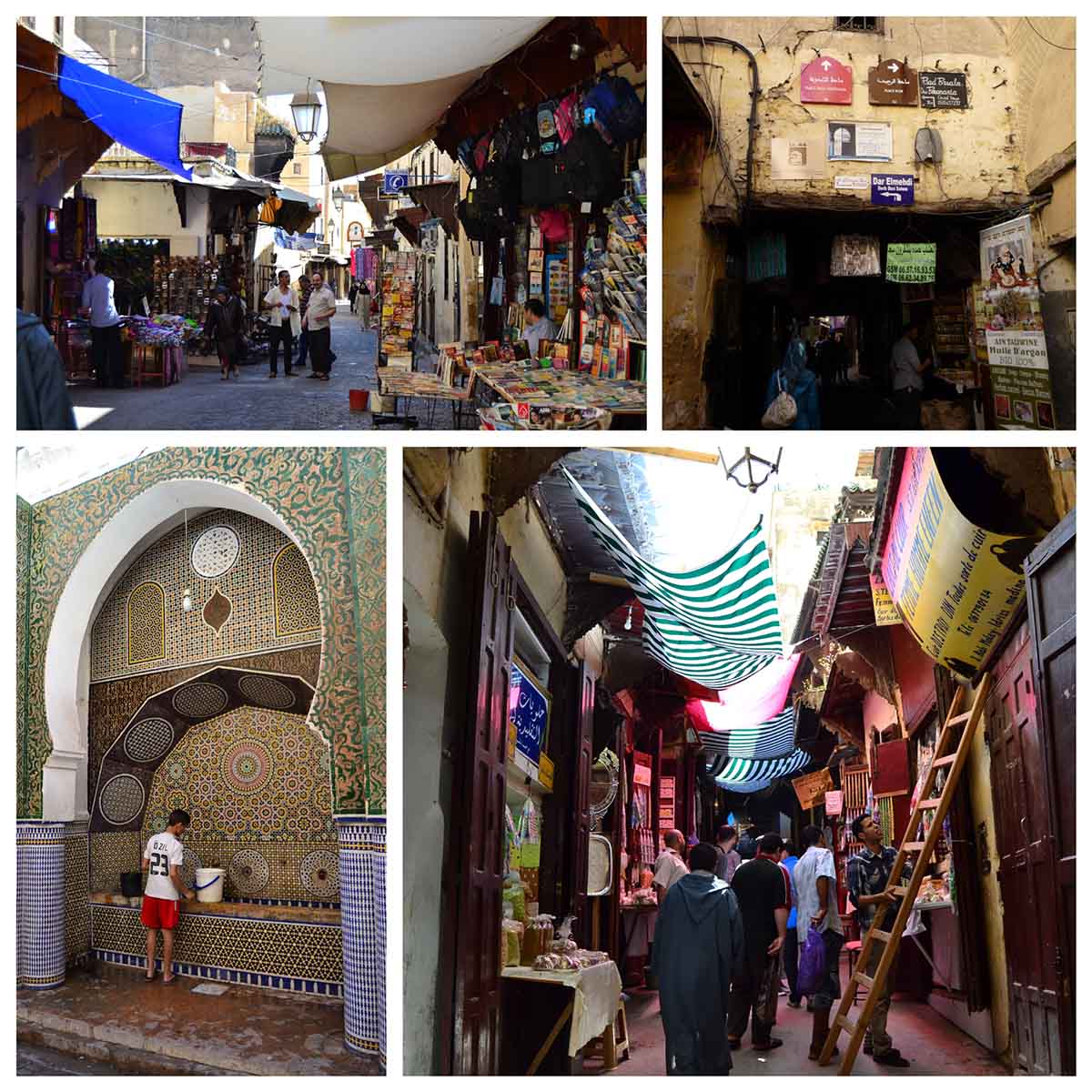
How to get to Fez
- By plane. Fez has its own airport with flights to other cities in Morocco or Europe. Royal Air Maroc, Ryanair, Air Arabia and Egyptair operate there, depending on the time of the year. You can get more information about the flights departing from Fez in this website.
- By car:
- From Rabat. Fez is just a 2:30-hour drive from Rabat, taking the A2 highway.
- From Meknès. Meknès is located between Rabat and Fès, so it’s possible that you choose to stop there and have a look around. Once you decide to keep moving, Fez will be only 1 hour away.
- From Chefchaouen. This is not the most common itinerary, but some people still choose to drive from Chaouen to Fez (or the other way round). The shortest itinerary is about 200km and takes at least 4 hours. There is no highway between these two cities, so the driving time can vary easily. If you go in the night, it may also be more tiring and slightly more dangerous.
Things to see and do in Fez
The city of Fez is separated into 3 different parts:
- Fes el-Bali: the oldest medina. This is where you will find most of the attractions and where you will spend the night if you decide to book one stay in a riad.
- Fes el-Jdid: the “new” medina. It’s still an ancient place, but it was the novelty when it was founded more than 700 years ago.
- Ville Nouvelle: the modern city.
A typical day in Fez consists, mainly, in visiting the two medinas plus, if you have time, going to a viewpoint or checking out some artisan workshops in the sorroundings. The medinas are quite labyrinthine and, years ago, it was extremely complicated to go all over them without a guide. Nowadays, everyone has a telephone with a location app, therefore one could visit them on their own (although sometimes the signal could be low). However, if the time is limited, or one wants to know more about the city, it’s a good idea to hire a guide that will take you through the most interesting areas and introduce you the local way of life.
If you decide to hire a guide, make sure that it is an official one. On one hand, official guides can speak different languages and have received proper education suitable for the job, so you can make the most of the visit. On the other hand, a faux guide may seem very cheap at the beginning, but will certainly ask for (a lot) more money by the end of the tour, and you may have to end up paying what you are asked, to avoid further problems. Moreover, Fez has a tourist police, and if a group is seen with a faux guide, they could even end up in a police station!
Official guides are easy to recognise, because they wear a djillaba and an a card that identifies them. You could try to hire one in the street, but the best option is to do it in advance; if you stay in a hotel, they will have the contact details of several guides specialised in different languages. You can check the rates of official guides in this website. Another choice is to make an online reservation of a tour before you make your trip to Morocco.
This said, let’s have a look at the most interesting things you can see and do in Fez.
The gates
The medina of Fez is sorrounded by a complex circuit of walls and gates. Probably, the most iconic gates are Bab Bou Jeloud and Bab Chorfa.
Bab Bou Jeloud is a symbol of Fez, as well as the main entrance to the medina. Built in 1913 during the French protectorate to replace a previous gate, it is decorated with zelliges and arabesques. It is also known as “The Blue Gate”, because that’s the colour one can see when entering the medina. However, if you look at the gate from the inside, you will realise that it’s green on this side.
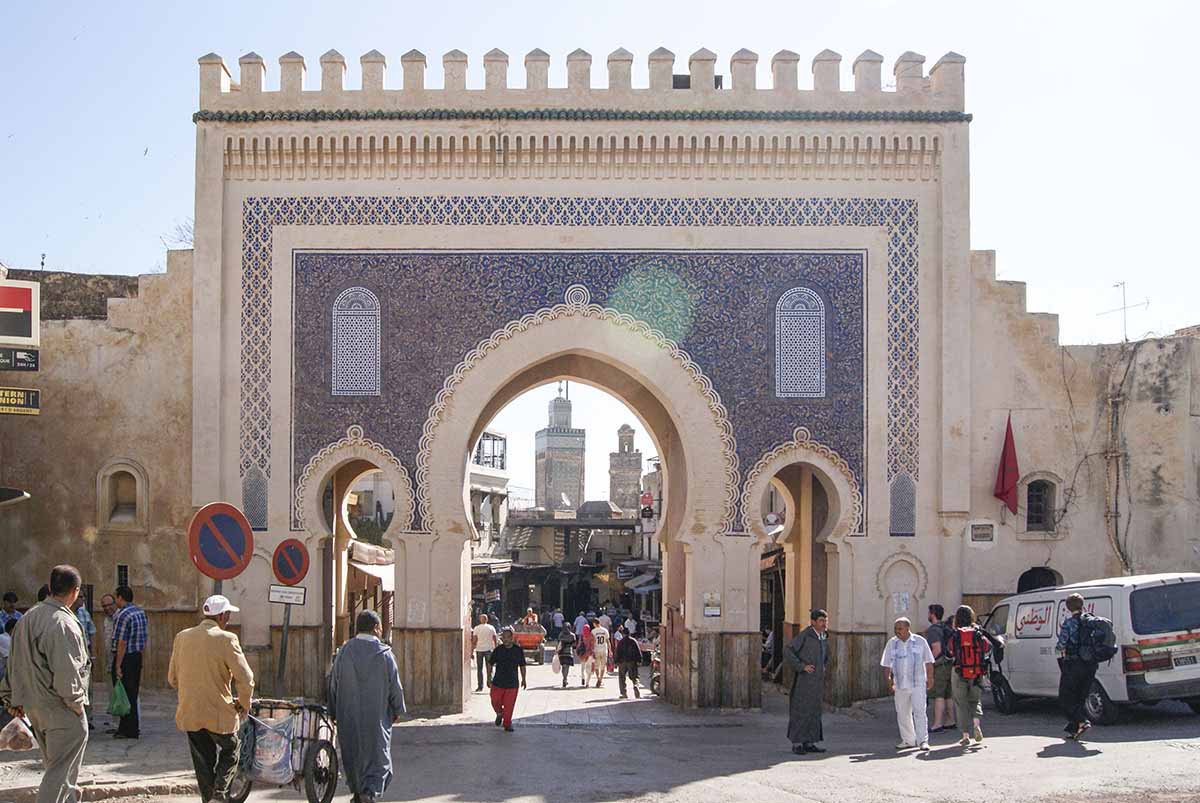
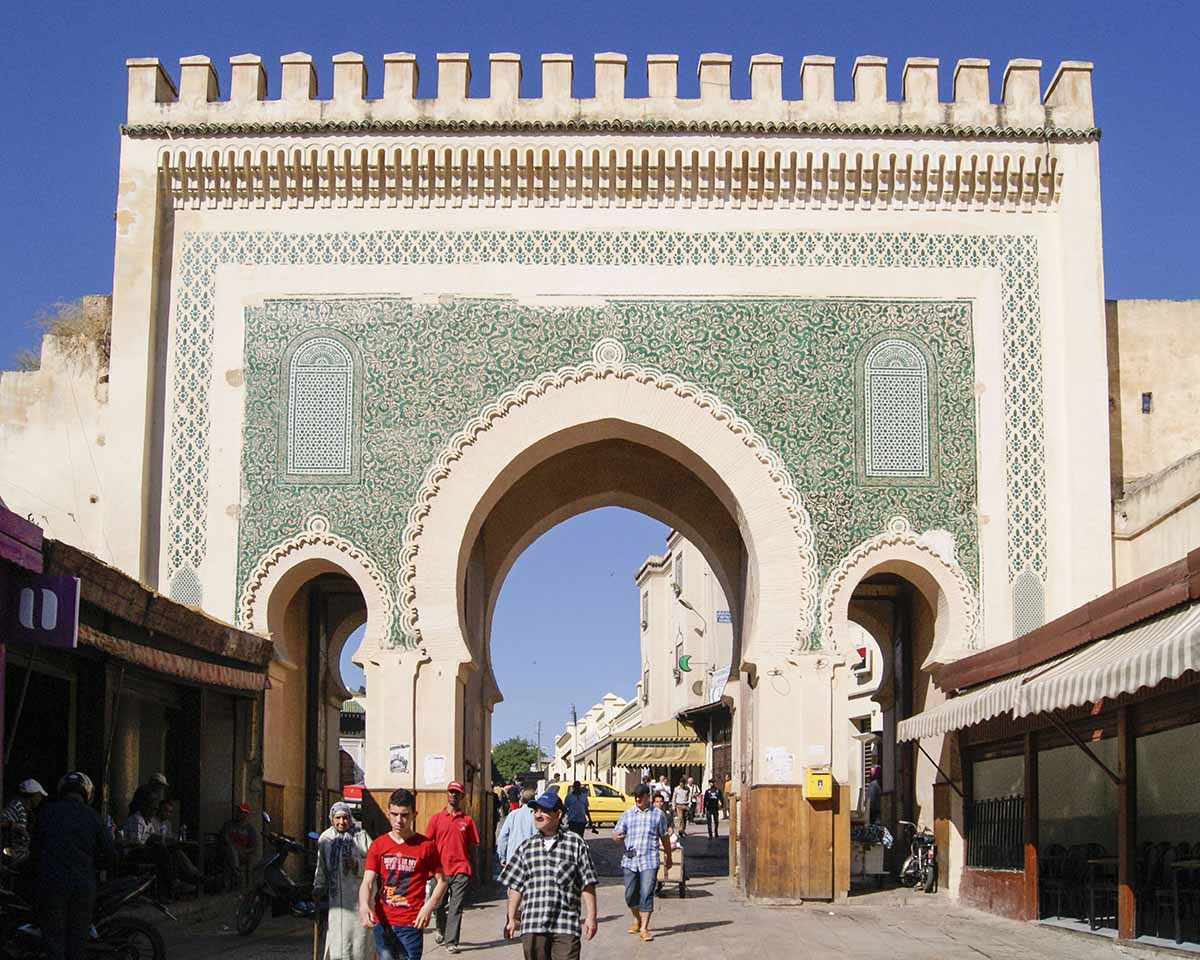
Bab Chorfa is another impressive gate at the west end of the medina. It gives access to the Kasbah An-Nouar. The gate was initially built in the 12th century, but it was restored in the 18th century, so the present form of Bab Chorfa dates back to that period.
The madrasas or Koranic schools
Of the eleven madrasas that Fez has, three are the most impressive, thus the most visited:
- Bou Inania (opened in 1350).
- Attarine (built between 1323 and 1325).
- Cherratine (opened in 1670).
Bou Inania is probably the best preserved, but Attarine is possibly the most beautiful one, so you we suggest you visit one of these two -or both-. Keep in mind that some parts of Bou Inania cannot be visited, as they still work as a mosque.
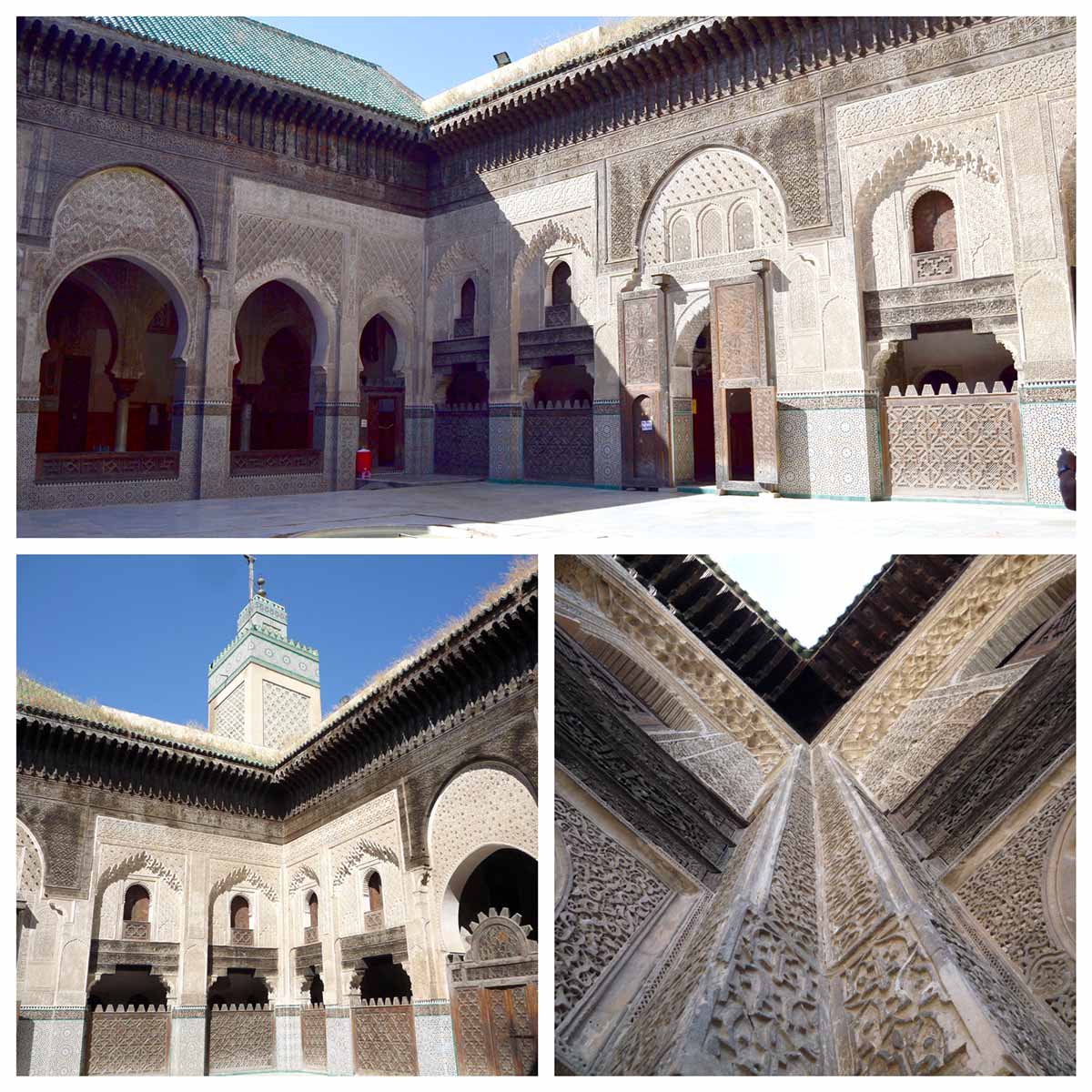
As some of the classes offered by these madrasas took place in the mosque Al-Qarawyyn, most of them were located in the area around it.
Mosque Al-Qarawyyn
As you may already know, non-muslims cannot go into mosques in Morocco, with the exception of the Hassan II Mosque in Casablanca. So… why should you get closer to the Mosque Al-Qarawyyn? If you move to the gate and have a look, you can get a glimpse of the court and admire its architecture, while you see people coming in and out.
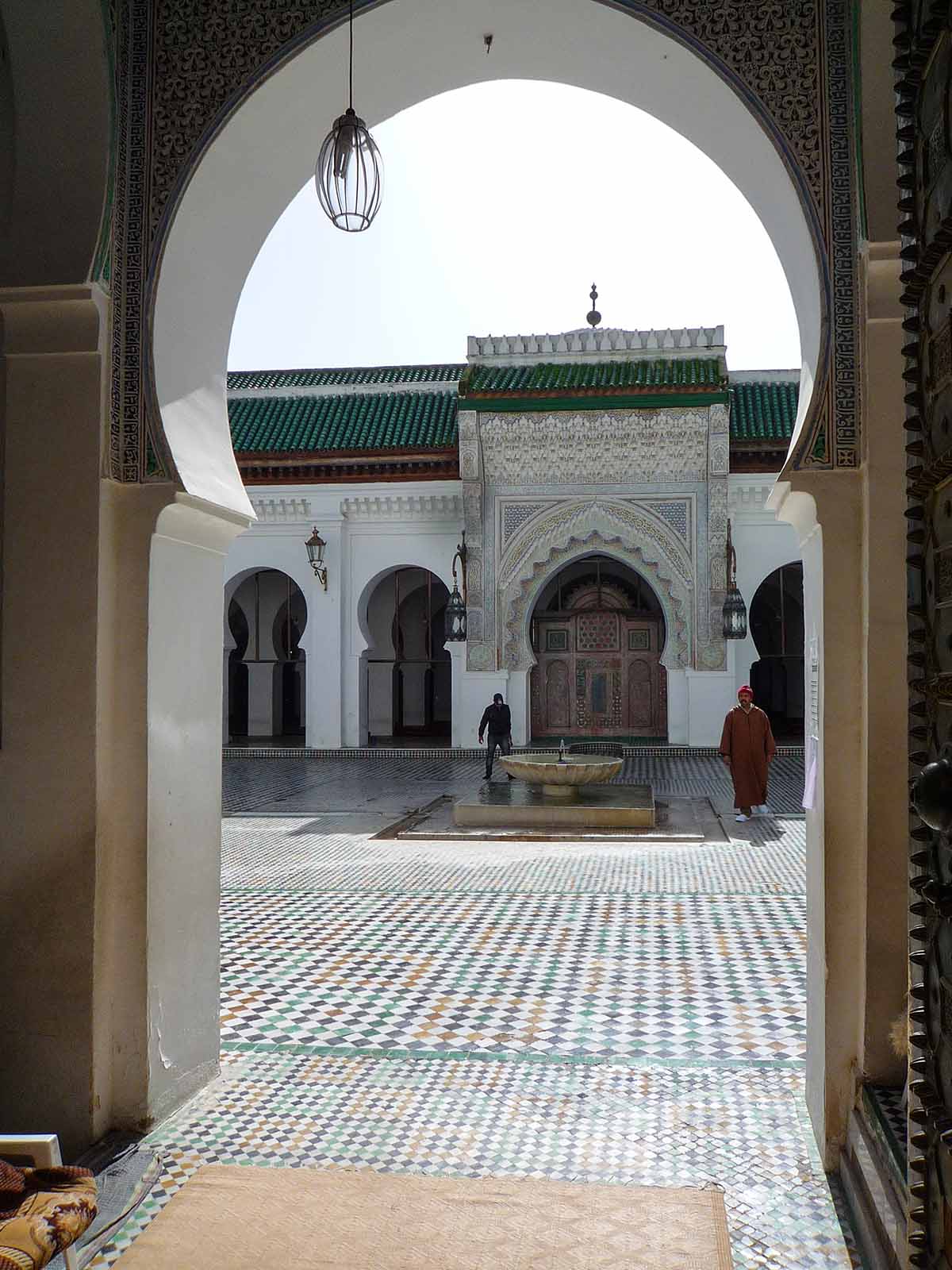
This mosque is related to the Univeristy of Al-Qarawyyn, located in the same site. Even if some people consider it was run as a madrasa since its beginnings, and it didn’t become a university until 1963, some sources such as UNESCO or the Guinness World Records have cited Al-Qarawyyn as the oldest university, or the oldest continually operating higher learning institution in the world. The institution was founded in 759 A.D. and welcomed, throught its history, students like Leo Africanus, Maimonides or Ibn Khaldun.
Mausoleum of Moulay Idriss II
Just a few metres away from the Mosque Al-Qarawyyin, you will find the mausoleum of Moulay Idriss II, who ruled Morocco from 807 to 828 A.D. and is considered the main founder of the city of Fez.
The current building, which underwent a reconstruction in the early 18th century and was restored in 2011, is one of the holiest shrines in Morocco. As it happens with mosques, non-muslims are not allowed to enter the building, but it is possible to have a look from one of the gates and get a glimpse of the interior.
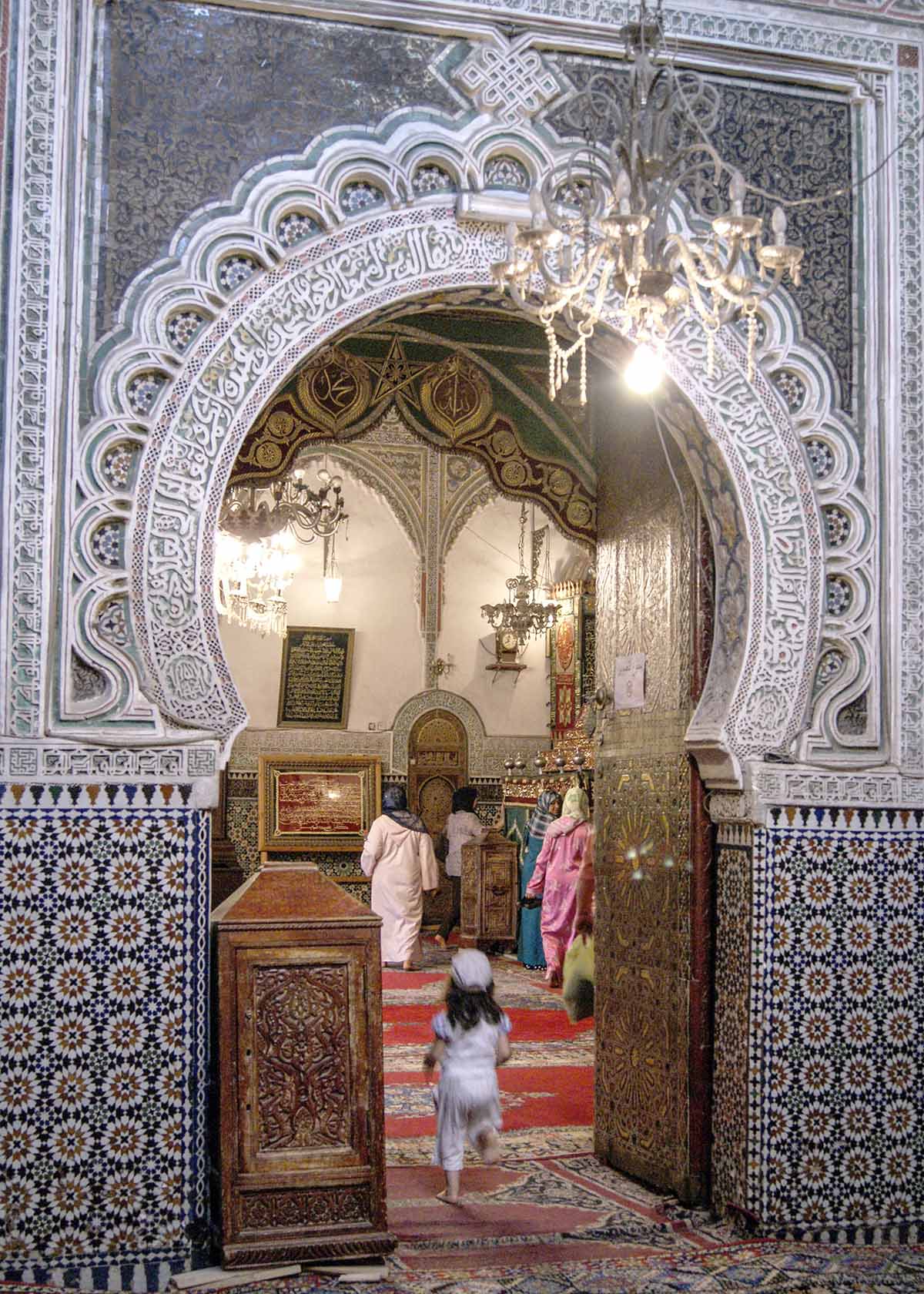
The souks
There are many markets along the medina of Fez el-Bali, each of them specialising in a particular type or range of products. The ones that follow are the most notable ones.
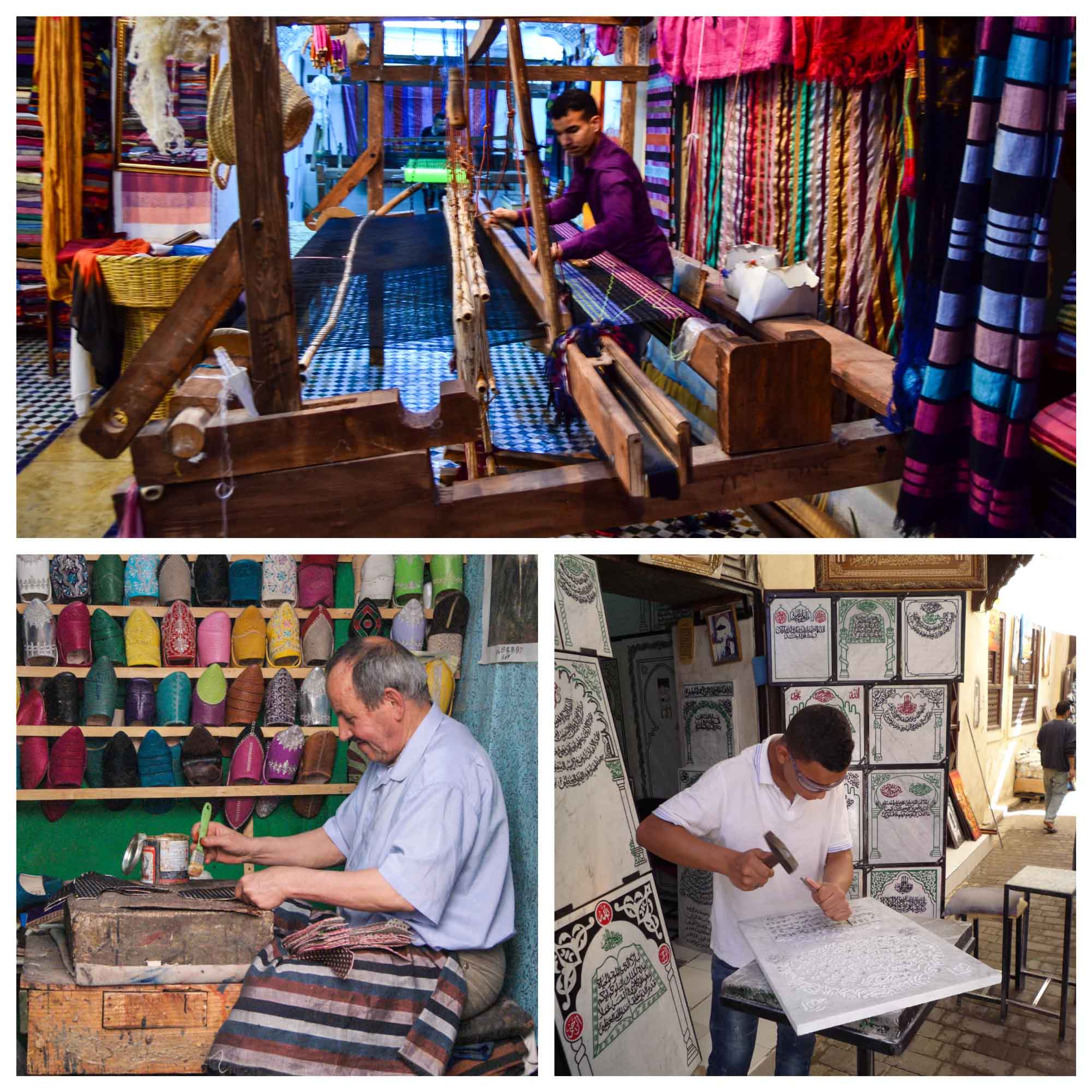
Henna souk
In this souk you can find cosmetics and traditional pharmaceutical products: henna, spices, kohls, aphrodisiacs, black soap…
Attarine souk
Although this souk lost some of its stalls, it’s still famous for the variety of spices you can find in it.
Nejjarine souk
Souk Nejjarine is the carpenter’s souk. In this area, you can find Nejjarine square. I’ts a relatively small square that is home to the Museum of Wooden Arts and Crafts. The museum is located inside a three storey building that used to be an inn for merchants (funduq). In this square, you can also see a fountain which is the oldest water supply in the city of Fez.
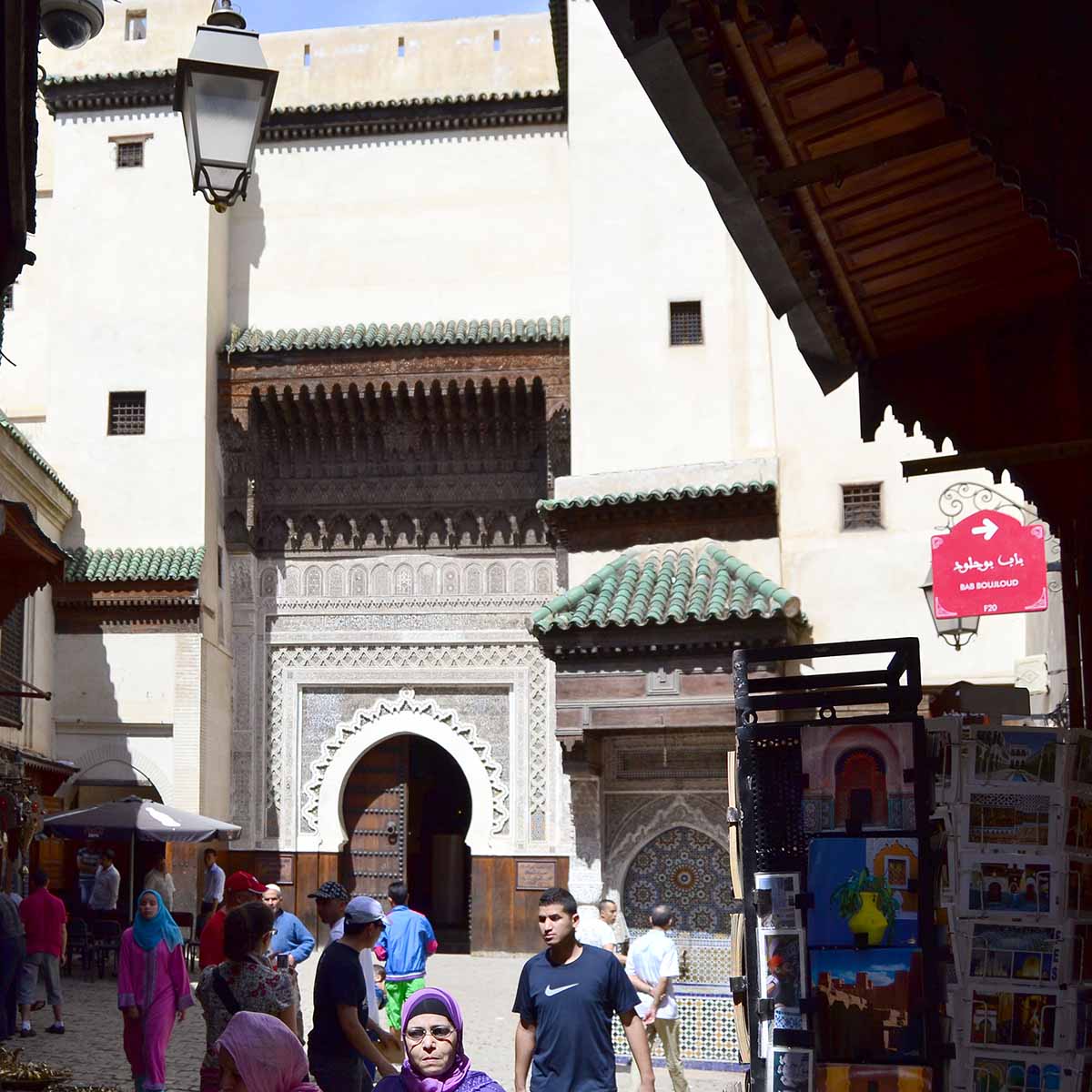
Sekkatine souk
This souk is specialised in the trade of equipments for horses, mules and donkeys. When you go to Fez you will rapidly notice that even if the streets are car free, there are still many donkeys and mules used as means of transport. Once you see them, you will probably hear the owner say “balak”, word that means that you have to move away and let them pass.
Bellagine souk
Although it has changed throughout the years, in this souk you can still find artisans that make wooden shoes and locks.
Chemainne souk
Once specialised in the manufacturing and sale of candles, nowadays you will find stalls selling dry fruits and nuts.
Achebine souk
This is the place to find chickens, eggs, birds and all kinds of poultry. Here, the animals are alive and in cages, waiting to be slaughtered only after being chosen by a client.
Metal souk
The coppersmiths gather in the area of Seffarine square (the word seffarin itself means coppersmith), a small square close to the Al-Qarawyyn Mosque with a tree standing right in the middle of it. Here, you can see these craftsmen in action, making pots, teapots, bowls and other copper items. You will realise when you are getting closer to the area beacuse of the sound of the men hitting the copper becoming louder.
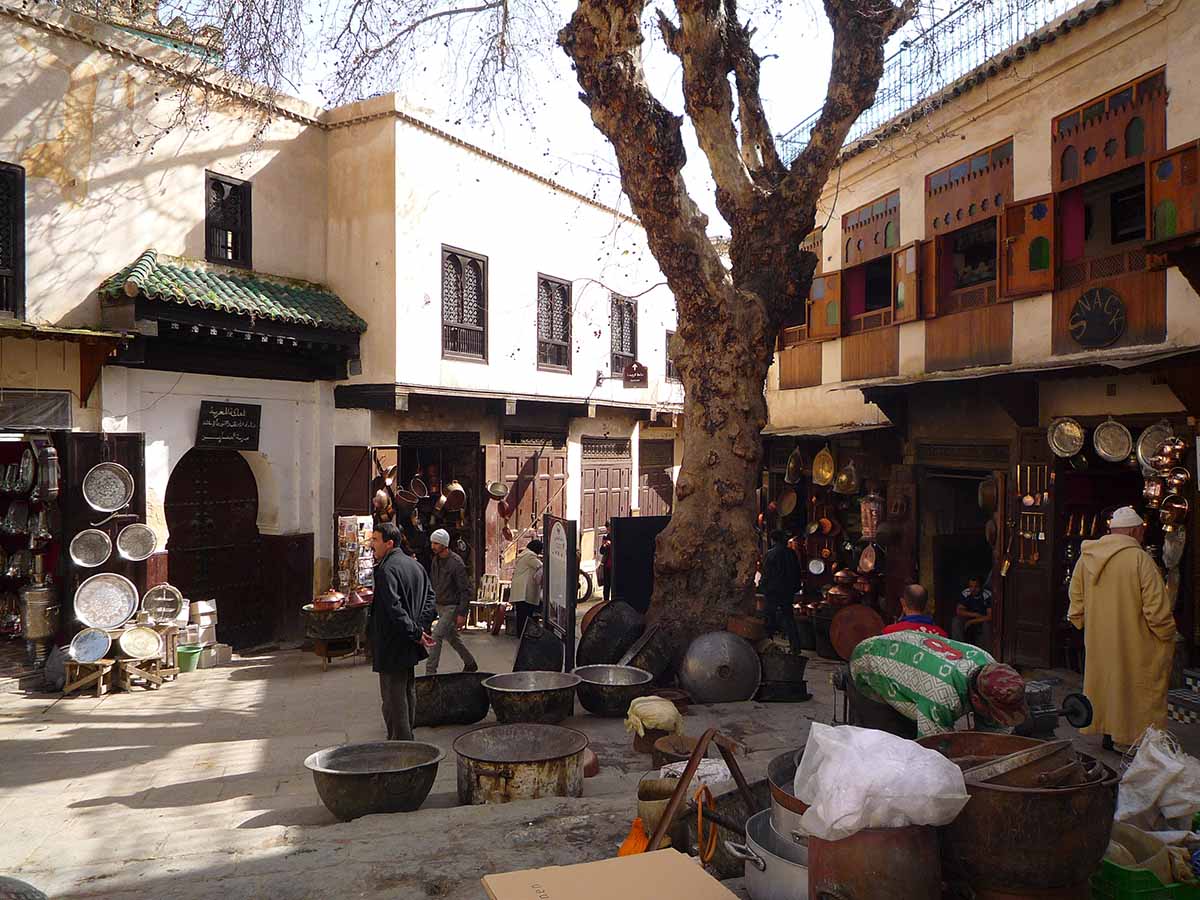
Tanners’ souk
Located in el-Blida neighbourhood, the tanneries of Fez are probably one of the main attractions in the city. When you visit the medina, you can guess you are getting closer to the tanneries because you start to see more and more mules and donkeys carrying pieces of leather, and you start to feel a very peculiar smell, which is not too pleasant (but also not as horrible as some people say).
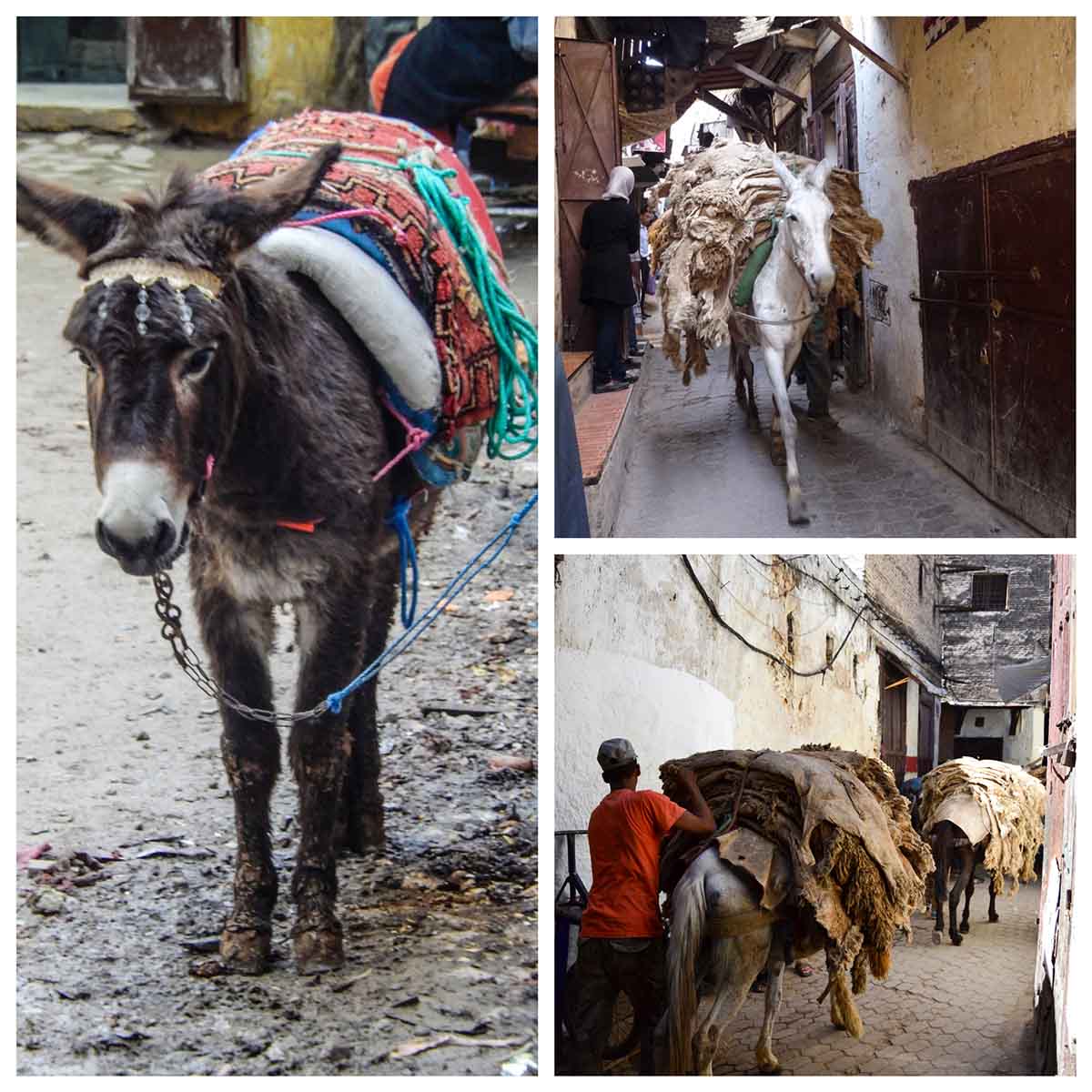
There are three tanneries still active in Fez: Chouara (the biggest and most impressive), Sidi Moussa (medium sized) and Ain Azliten (the smallest). Here, the leather is tanned in the traditional way, following methods that haven’t almost changed in the last 1000 years. The tanneries are sorrounded by houses with rooftops from where you can see all the manufacturing going on. These houses usually have shops inside; you will be told that you can go to those terraces for free but, if you don’t buy anything (and be ready to face very insisting sellers) you may have to leave a tip.
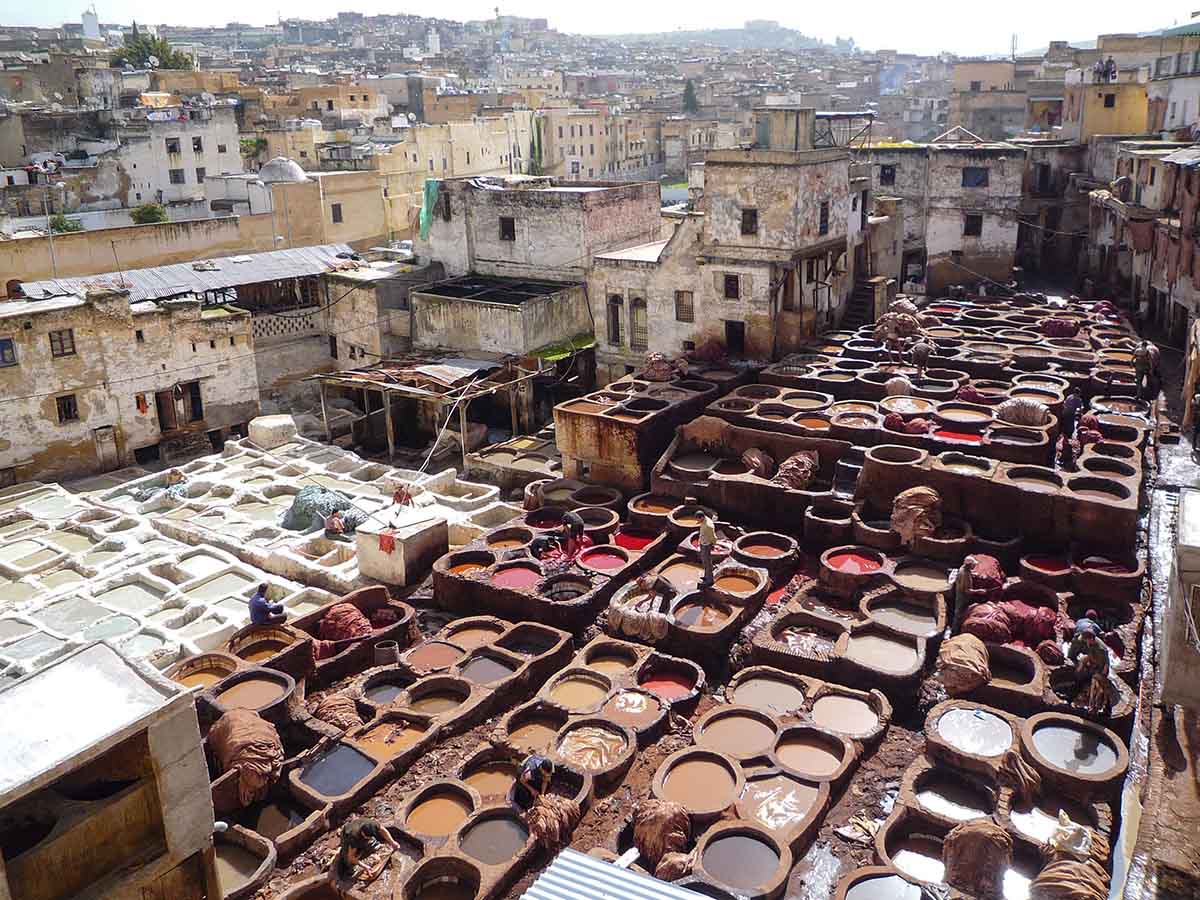
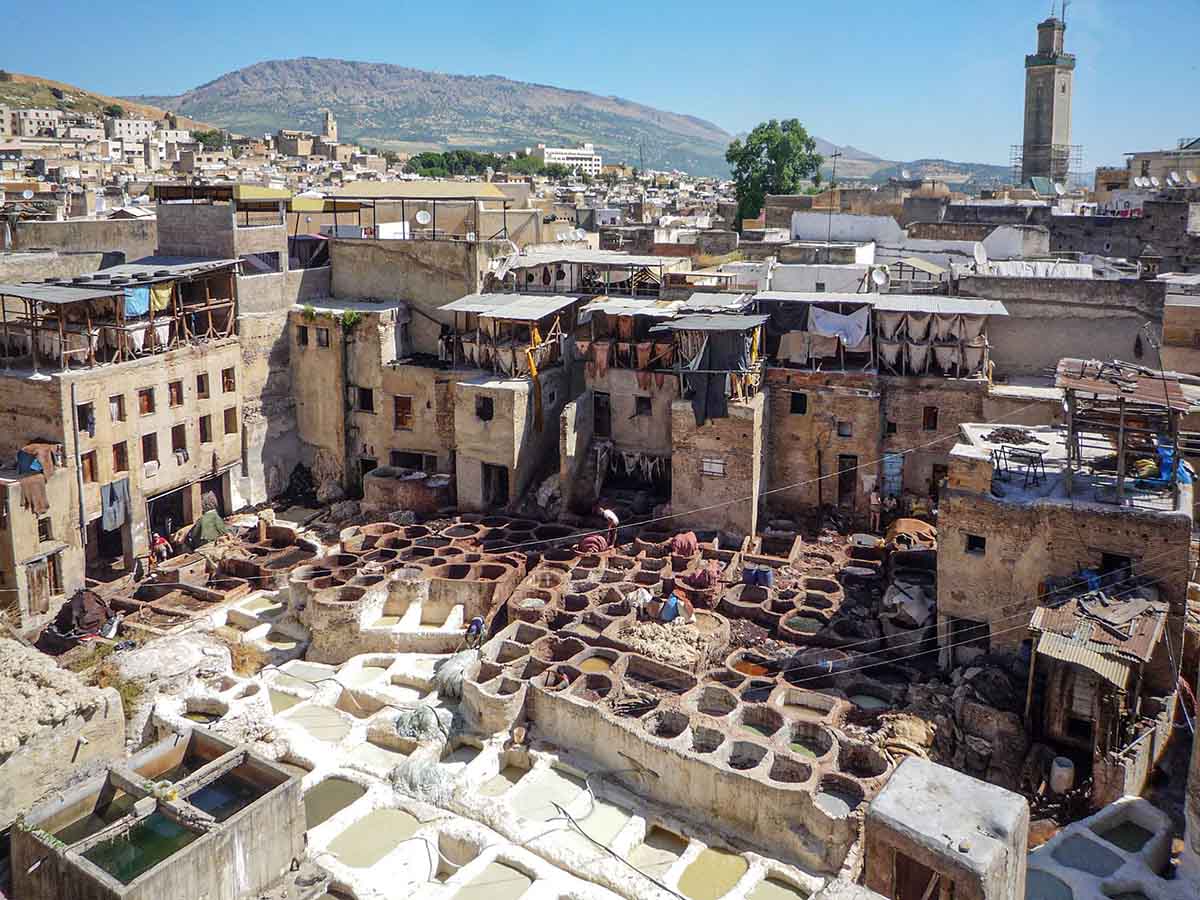
From the rooftops, one can see the tanning process. First, the peaces of skin (of cow, sheep, goat or camel) are introduced in tanks that contain pigeon excrement, and left there for some days. These are the white tanks. After this phase, the tanners remove any hair that is left on the skin and move them into the coloured tanks full of natural pigments. They use poppy flower for red colour, indigo for blue, henna for orange, minth for green and saffran for yellow. Once coloured, the pieces of skin are dried, first in the area of the tanneries and later on the hills that sorround Fez. And when they are completely dry, they are taken to the artisans that will make many different products out of them, such as purses, coats, suitcases or shoes.
The Royal Palace
Fez is one of the imperial cities of Morocco, and as such, it has a royal palace (Dar al-Makhzen). As it happens with mosques or the other royal palaces in Morocco, it cannot be visited, so the only thing one can do is stare at the impressive gates (built between 1969 and 1971) and the walls that sorround it.
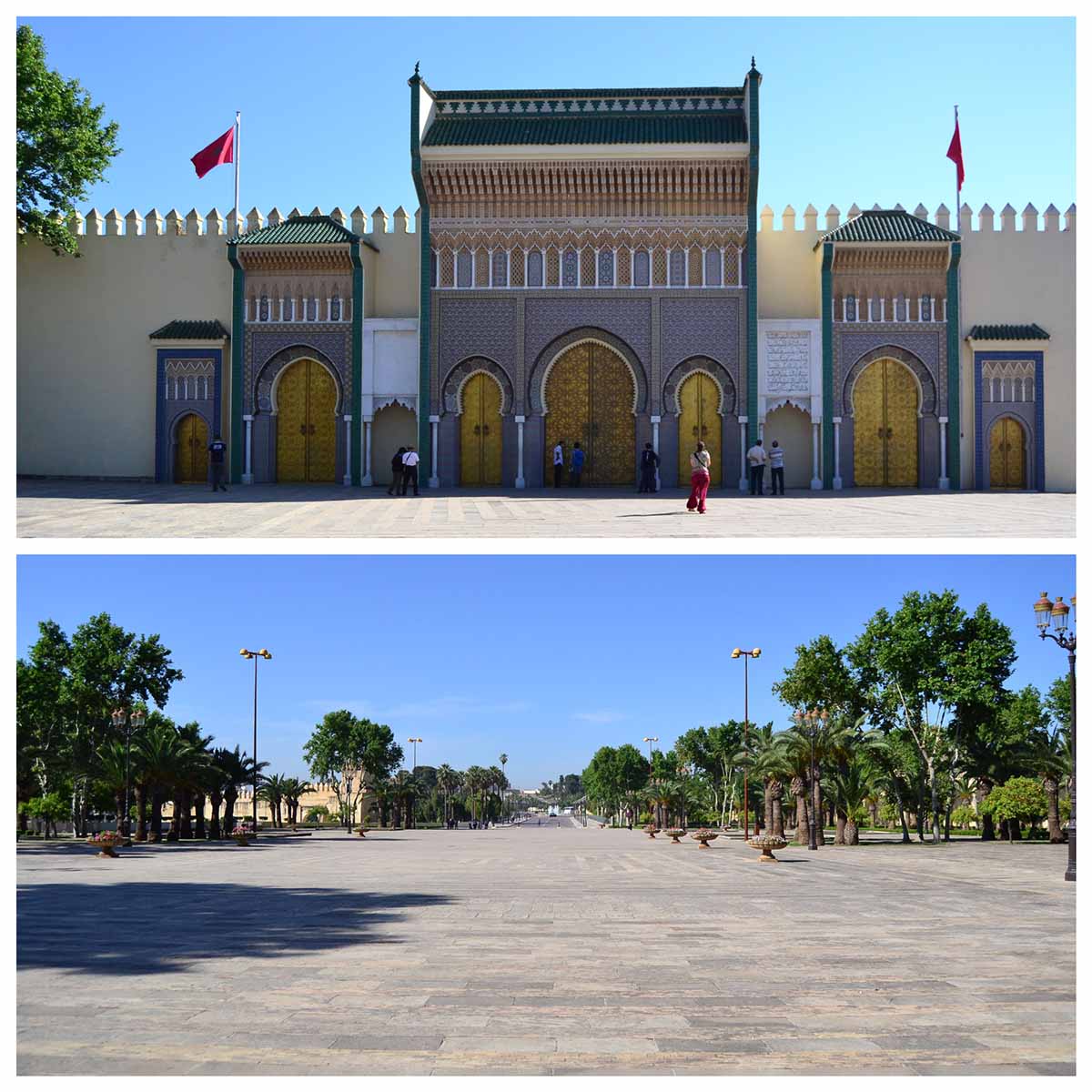
The mellah or jewish quarter
Right near the royal palace, in Fez el-Jdid, visitors can find the mellah, the historic jewish quarter, where this community lived for centuries. It is said that the word mellah has its origin in the word “salt” (in arabic), because jewish merchants used it as currency.
This quarter is no longer inhabitated by any singnificant jewish population, most of them having moved to other areas of Fez or elsewhere, but one can still observe the architectural differences between this quarter and the muslim communities. One of the most striking differences is the presence of open balconies facing the street and several windows, whereas the muslim houses are generally closed-off from the outside. Another difference is, as expected, the many synagogues that can be found in this neighbourhood.
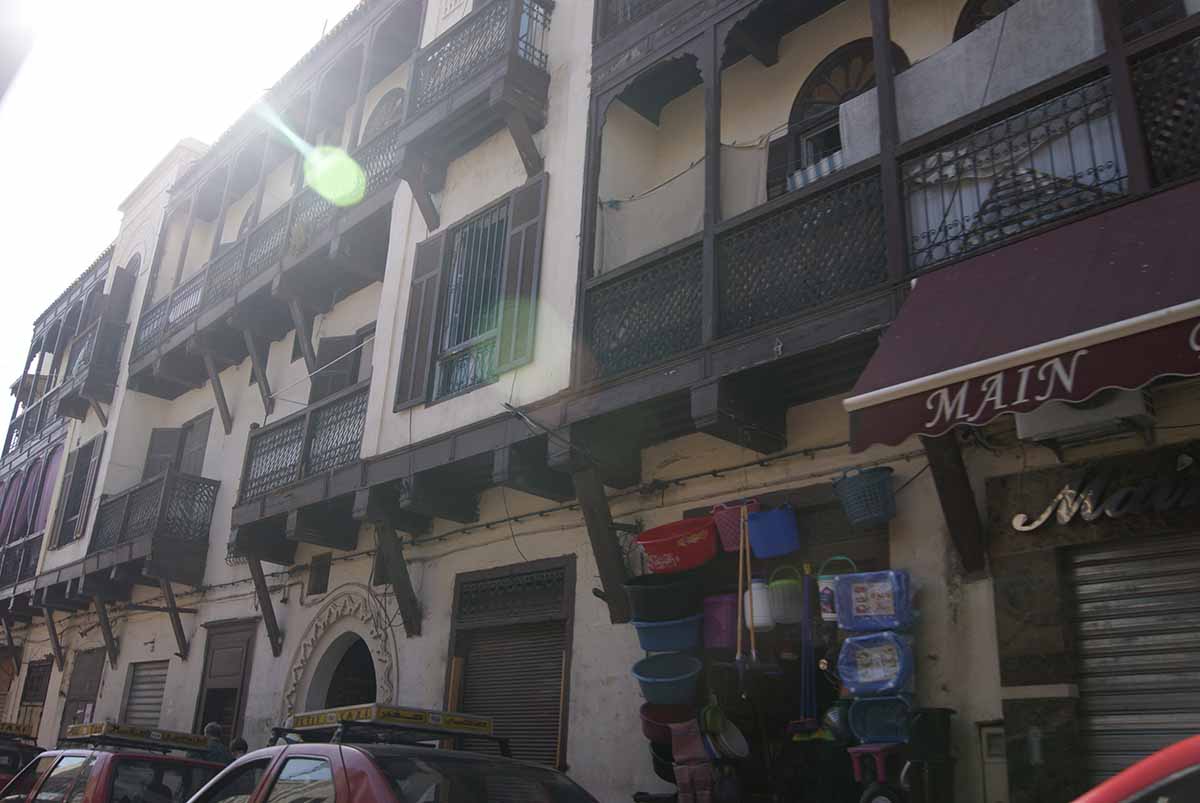
Viewpoints
There are several hills sorrounding Fez, therefore it’s not hard to get a panoramic view of the city. The view from this perspective can make the visitor aware of the extension of Fez.
These are two places where you can go:
- Borj Nord (GPS coordinates: 34.0539736 N, 4.9705441 W). In the north of Fez, there is a fort guarded by armed and uniformed officers; from its remparts, you can have a good view of the city. The fort, that was used as prison during the French protectorate, houses now the Arms Museum.
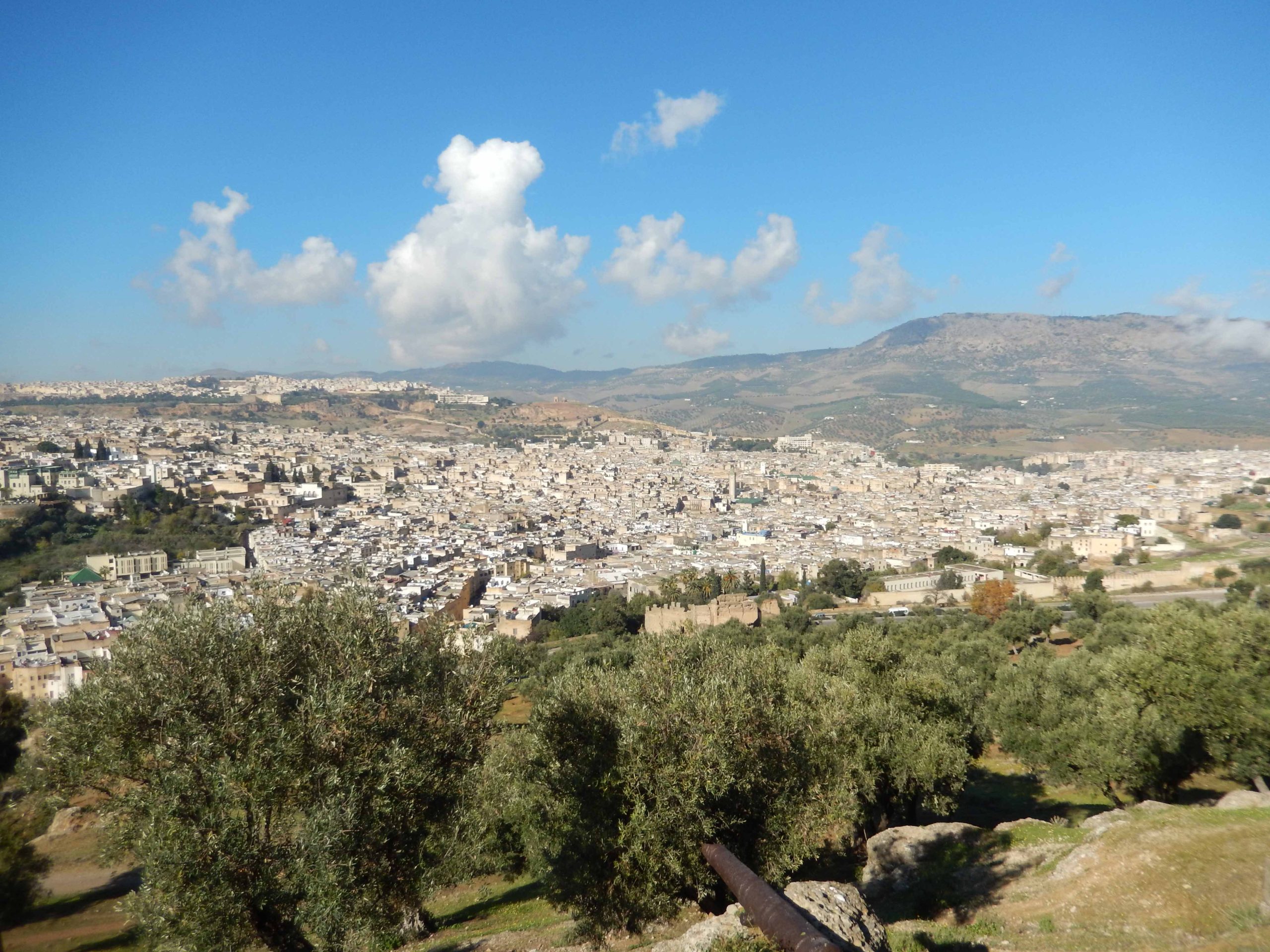
- Marinid tombs (GPS coordinates: 34.0698866 N, 4.9816212 W). In the 14th century, the marinid dynasty built a mosque and a palace outside the hill, but the only remains today are these tombs that were probably built to honour the royal family. The view from here is also impressive. And, while you are there, you can also see the Bab Guissa cemitery.
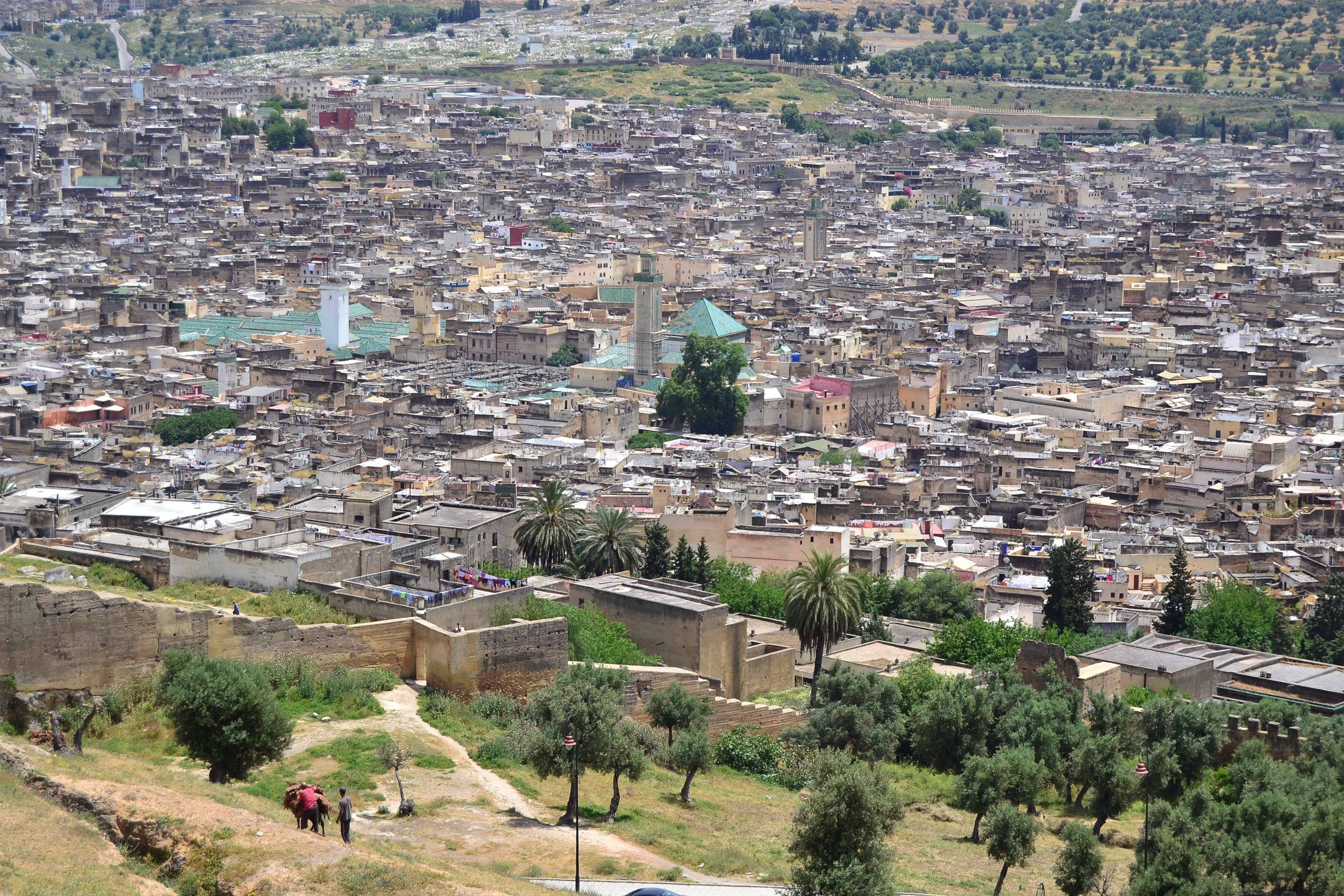
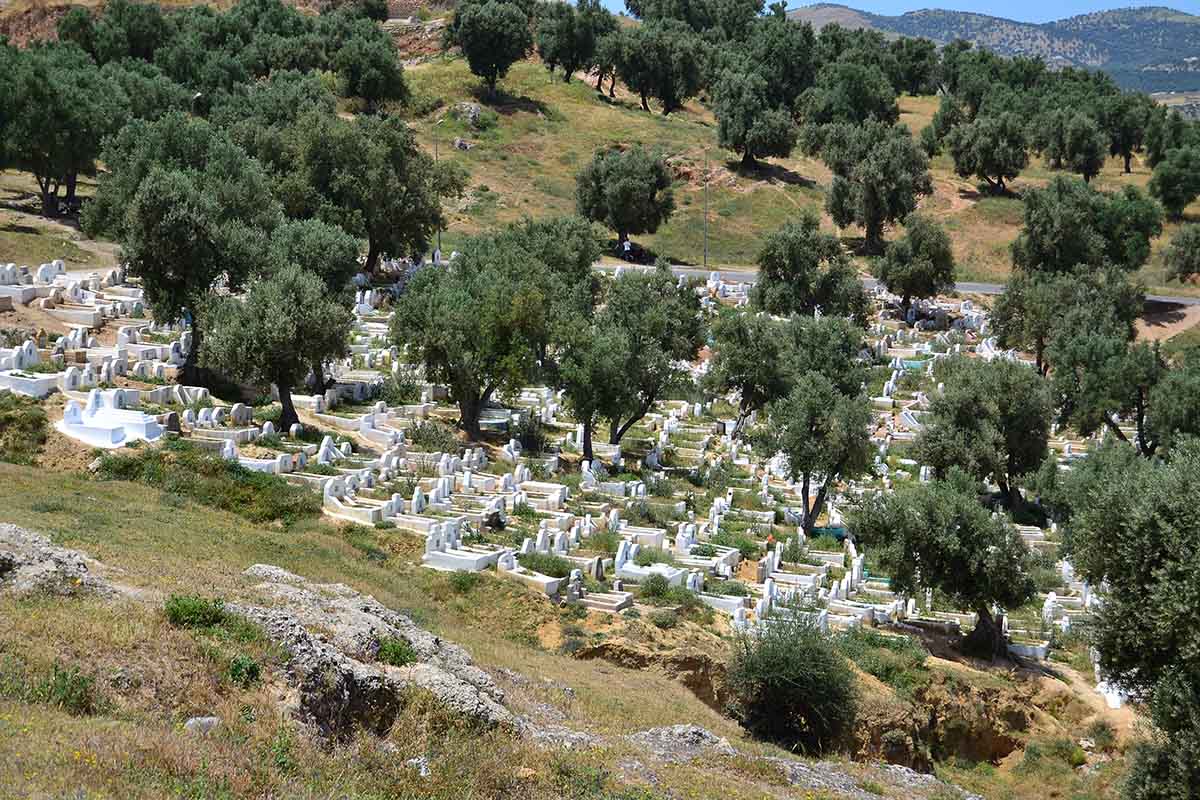
The best time of the day to go to these viewpoints is the early morning or the end of the evening.
Pottery factories
Fez ceramics are probably the most elegant in Morocco, standing out for their quality and their design (which also comes with a price). You can visit one of the factories to see all the artisans in action, making from more simple pieces such as plates or tajines to more complicated ones like mosaics for tables or fountains. Some of these factories receive orders from all over the world.
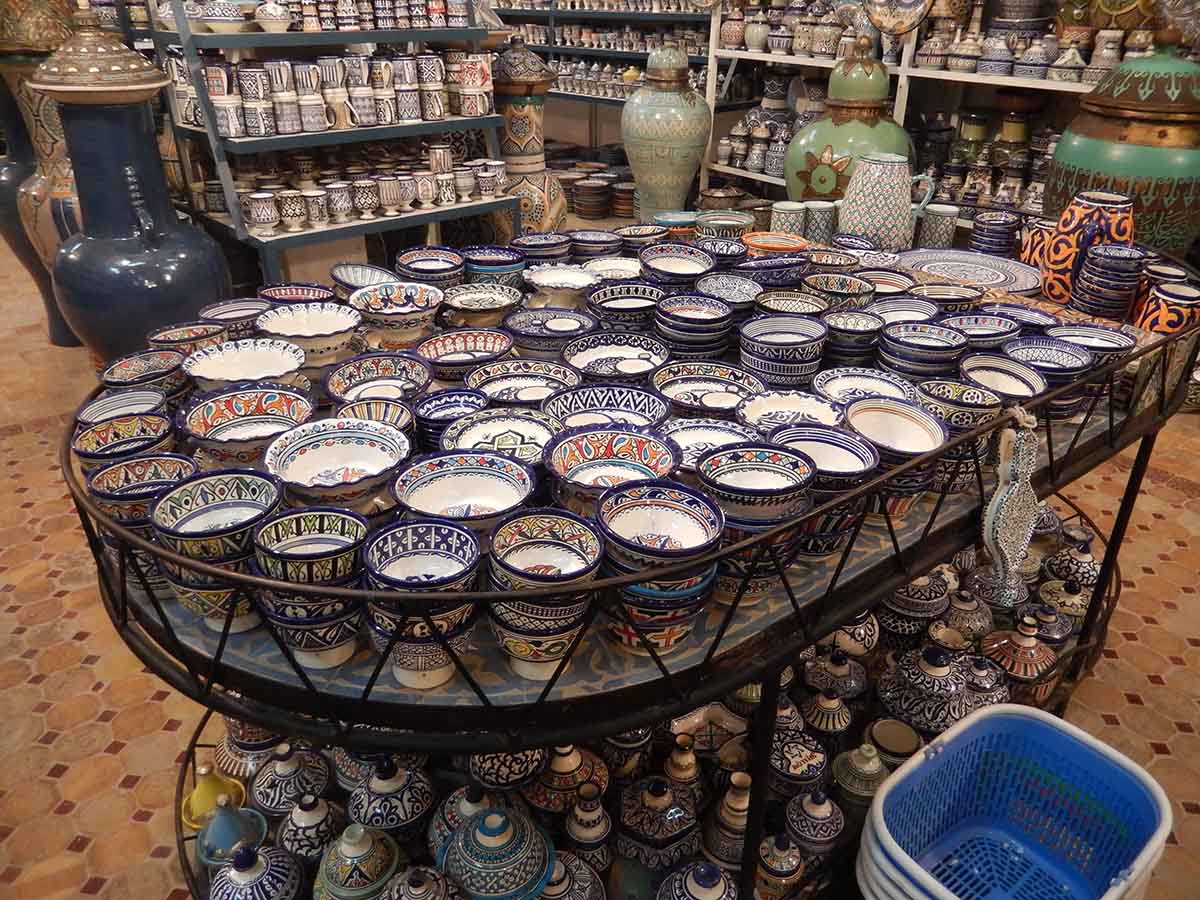
Where to stay in Fez
There are many hotels in Fez, both in the medina and the ville nouvelle. The hotels in the ville nouvelle tend to be big and more modern, sometimes belonging to big brands, and are similar to any other in the world. On the contrary, the hotels in the medina are usually small independent riads (or dars, because not all of them can be considered riads) and quite unique. If what you want is to live a more authenic experience, then we suggest you go for a riad in the medina.
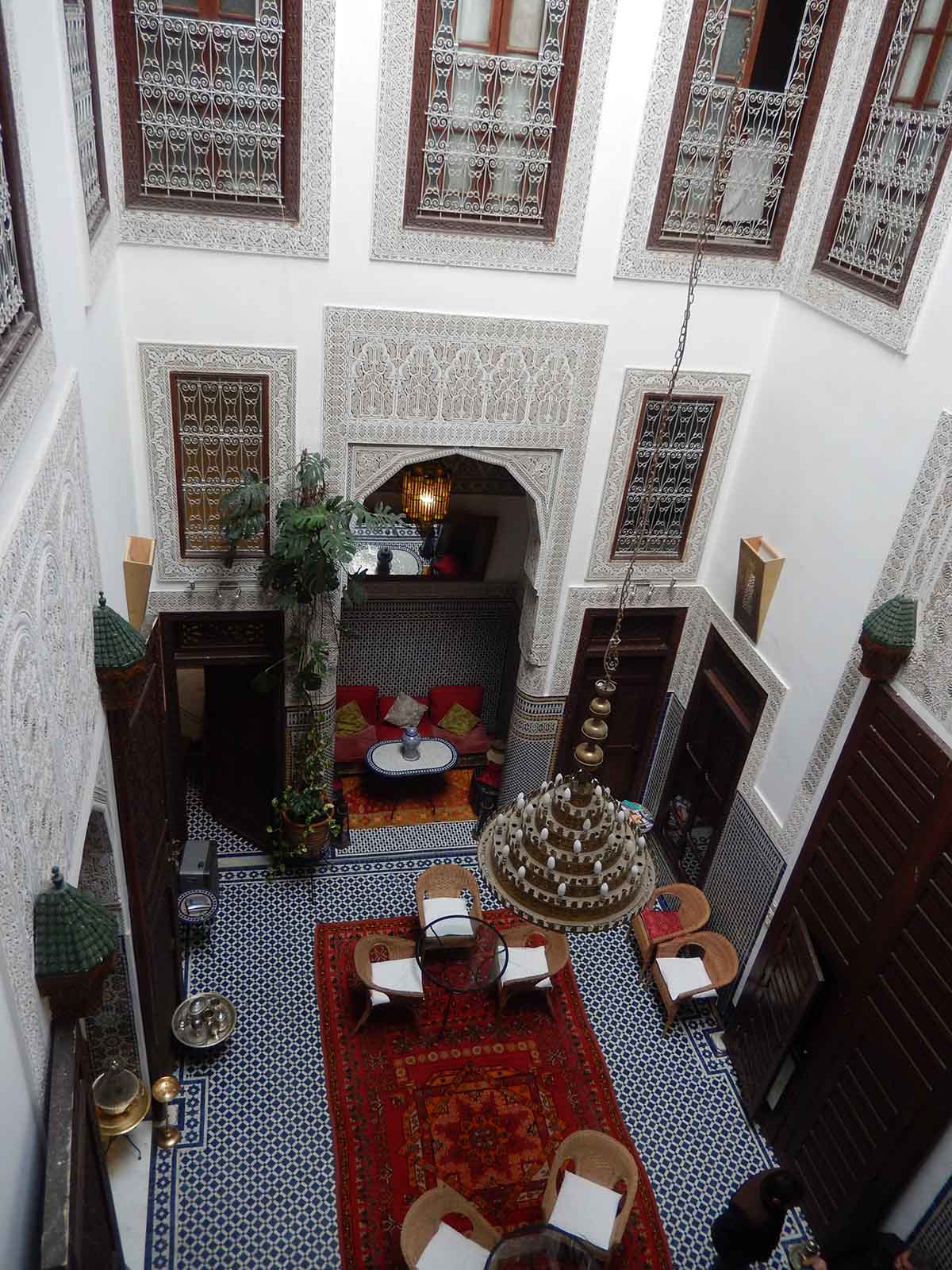
In conclusion…
There are many places in Morocco that are worth a visit, and Fez is definitely one of them. If what you read about Fez seems interesting to you, then we are almost sure that you will live an unforgettable experience.
And if you have already been to Fez… have you enjoyed the visit? Is there anything you would like to share with us? If that is the case, leave us a comment!
